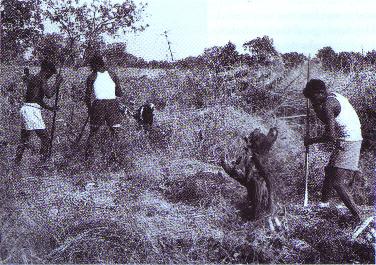THE MAKING OF BABA AMTE ... contd
But beneath this external extravagance, a deep restlessness was brewing. This surely could not be the purpose of life, he thought.
"I, who never had planted a smile seed in the estate, was expected to enjoy the comfort of
a beautiful farm house while those who had toiled there all their lives had only the meanest
hovels... I was charging 50 rupees for arguing for 15 minutes, while a labourer was getting
only 3 quarters of a rupee for 12 hours of toil. That was what was eating into me".
So he set about changing what he could. Harijans (social outcaste untouchables) had to
walk a long distance to collect water because they were forbidden from using the village well. Defying the bitter opposition of his family and other upper caste villagers, Muralidhar opened the family well to all people. Continually jolted by the poverty and degradation of the peasantry, he began also organising farmers' cooperatives.
His sharpened social conscience led him as a volunteer to sites of disaster such as the Quetta earthquake of 1935 and the Bengal famine of early 1940s. In Bengal he came under the
spell of Rabindranath Tagore's music and poetry. He visited Shantiniketan a microcosm of
Tagores ideal world, a community united in joy, work and love. He came away deeply touched
and somehow altered for life. Closer home was Sewagram, where a new paradigm of development was being forged br Mahatma Gandhi, as an integral part of the struggle against colonial rule. Muralidhar took an active part in the struggle. During the Quit India Movement of 1942, he organized lawyers to represent jailed nationalist leaders and was himslef thrown into prison.
"It was indeed no small privilege to be living in the company of two universal souls that
inhabited Shantiniketan and Sewagram. I felt honoured to be able to quarrel with both of
them, yet to love them immensely and also earn their love'.
Apart from Gandhi and Tagore he was drawn like a magnet to the poetic simplicity of
Maharashtra's fiery social reformer Sane Guruji. For some years he even became a sadhu, complete with matted locks, saffron robes and a vow of celibacy. He roamed the Himalayas, living with sadhus, practicing yoga. But destiny had other plans in store for him.
In 1946, at a family wedding, he saw Indu Guleshastri, the youunger sister of the bride,
quitely helping an overburdened servant woman. "I thought no ordinary Brahmin girl would
stoop to washing other people's clothes when she could be enjoying herself. Something deeply stirred inside me". The celibate had to work hard to persuade Indu's parents that he was indeed a suitable groom. Sadhana Tai recalls the incident. "Everyone was shoked at this sadhu directly approaching us. But I liked it' I didn't want an ordinary life, I knew with this unusual man I would not be just a housewife.. My parents were even more shocked when I agreed." They got married m December 1946.


